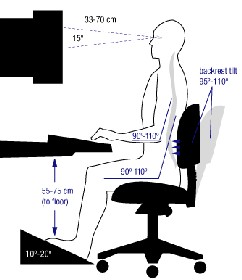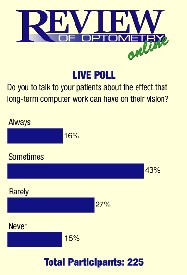 |
Much has changed in the world of computer vision since 1999, the year the AOA began working with the Occupational Safety and Health Administration and Congress to formally recognize CVS as a legitimate eye malady. Recent studies show that not only is CVS a real health concern, but public awareness of it is growing. A study released in January, 2004 may give employers a reason to provide vision insurance for employees.
Here, well look at how new information about CVS may affect your patients, their employers and your practice.
The Employment Environment
The Kaiser Family Founda-tion reports that premiums for employer-sponsored health insurance rose by 14% from 2002 to 2003. Thats the highest premium increase since 1990 and the third year in a row of double-digit premium increases. This has forced many employers to cut back on employee benefits, and vision care is often one of the first to go. Review of Optometrys annual Staff Salary Survey (see Are Staff Benefits Caught in A Squeeze, November 2003) found that fewer O.D.s provide health coverage for their own employees.
Jobson Optical Research found that 65% of employers offer vision care to employees, but two-thirds limit coverage to eye exams and to one pair of spectacle lenses per year or two years. This can make the expense of an extra pair of glasses hard for patients to swallow. Jobson also found that the number of adults who have vision coverage is on par with the number of those who dont (around 46% in each group).
Studies published since the 1990s have indicated the importance of correcting residual astigmatism in patients who work extensively on computers.1 A new study from the University of Alabama at Birmingham College of Optometry examined both visual science and economic projection to investigate whether there is a relationship between the astigmatic refraction corrections of subjects and their productivity and visual comfort.2
The double-masked, placebo-controlled, randomized study found that a miscorrection of as little as 0.50D can lower productivity by 9% and accuracy by 38%, even when subjects report no symptoms.
|
Coding for CVS |
|
Until specific CPT and ICD-9 codes are approved for CVS youll need to decide for yourself how to bill third-party plans when patients present with apparent computer vision syndrome.
If you choose to treat CVS as a medical problem, then you may be able to include testing for CVS as an incidental test to the medical office visit. Follow the same rules and guidelines as you would for other conditions with appropriate documentation and coding.
If you choose to treat CVS as an optical problem, testing and treatment will be "noncovered" services and the patient will be responsible for payment.
Whichever you choose, be consistent with every patient.
Soden R. Do third-party plans really pay for CVS care? Optometry 2002 Apr;73(4):249-52. |
The study also found that providing computer eyewear for employees would equal a cost/benefit ratio of 18 to 1 (thats $18 for every $1 spent) for employers. This study give employers hard evidence of the financial benefits of providing computer eyewear for employees who use computers, says the studys chief investigator, Kent Daum, O.D., Ph.D.
The Tasks
The UAB team followed 39 subjects ages 19 to 30. Each participant received a complete vision exam and was randomly assigned to wear either corrected or uncorrected lenses. None of the participants knew whether they were given their correct prescription or not, Dr. Daum says.
Researchers had the subjects complete several tasks on the computer to assess the effects of the refractive error on productivity. Even when symptoms were not reported and the computer screen was seen clearly, we found differences in productivity and accuracy over time, Dr. Daum says. The greater the miscorrection, the greater the decrease in productivity.
The results of the study support the importance of accommodative testing for patients who log long hours on a computer. Even a 0.25D change can make a huge difference in a patients comfort level at the computer, says Robert Davis, O.D. of Pembroke, Fla.
|
The Importance of Ergonomics |
Often, the only treatment necessary for computer vision syndrome is alter to the patients workstation, says optometrist Robert Davis. Ergonomic guidelines generally require that video display terminals:
Have adjustable brightness and contrast between background and text.
 |
Are free from reflections, glare and screen flicker.
Can rotate and tilt easily.
Are at an appropriate height above the work surface. The top line of text should be just below eye level (15 degrees).
Have no more than six colors simultaneously displayed.
Some additional guidelines: When sitting at the computer, the patients forearms should be parallel to the floor. Elbows should be positioned at a right angle between the upper arm and forearm. Shoulders and upper arms should be relaxed.
The patients wrists should be flat over the keyboard in a neutral position, not resting against a hard or sharp surface. Wrist pads and rests should be used only when the patient is not typing.
The diagram below illustrates the proper ergonomic posture. |
Based on the results of our study, there would seem to be good reason for employers to address this issue. The recognition of the effect of refractive error on visual performance would be helpful to vision care, business, employers and employees, says Dr. Daum.
Some employers have begun offering computer eyewear for employees. These include AT&T, State Farm Insurance and the Social Security Administration.
However, assessing the productivity of a company can be extremely complex. Thats because myriad factors contribute to a companys productivity, including the employees skills, management of the company, required technology and availability of necessary materials and a wide variety of other factors. But, according to Human Resources magazine the process is worth going through since increased productivity is an influential factor in whether a business succeeds or fails.
The Patients Perspective
It may not be as hard as you think to convince patients that computer work can affect their vision. Opinion Research Corporation and the Computer Vision Syndrome Information Center (www.cvseyeinfo.com) conducted a recent survey for the AOA and found that 61% of consumers surveyed were concerned about CVS, and 75% believe CVS should be a recognized problem similar to carpal tunnel syndrome.
The AOA and the Federal Occupational Safety and Health Administration (OSHA) have recognized CVS as a legitimate occupational program associated with prolonged computer use in the workplace, says James Sheedy, O.D., Ph.D., associate professor of optometry at Ohio State University.
The Computer Vision Syndrome Information Center is a group that, in cooperation with the AOA, was formed in 1993 to help people clearly understand and recognize the various symptoms of CVS and how it can be treated. They estimate that three times as many computer users suffer from CVS as from carpal tunnel syndrome, and 90% of those patients with CVS work more than three hours a day on the computer. This makes an extra pair of lenses for computer work that much more important.
|
Diagnosing CVS in Contact Lens Wearers
By Robert Davis, O.D. |
Diagnosing CVS problem is the most challenging aspect of CVS in contact lens users, especially because, in most cases, patients will be convinced that their lenses are to blame.
First, check to make sure the contacts are not indeed the problem. I try to get the patients to a point where the lenses are so comfortable they dont feel them at all. With some 45 different contact lenses on the market today to choose from, this can be time consuming. I narrow the field by favoring lenses that do not dry out easily and ones that also center very well. A lens that does not center well will create problems for computer users because the angle of their gaze tends to be slightly elevated.
I also look for a lens that provides good movement. To assess movement, I do a push-up test. While wearing the lens, the patient is asked to look up. I then study the limbal vessels to see if there is any limbal drag. If there is, the lens is probably too tight.
Once you are confident about the contacts, check on possible conditions of the cornea. Rule out dry eye early. This may be difficult since CVS can be the very cause of dry eye. The best way to rule out systemic dry eye is taking the time to perform a Schirmer test.
-Dr. Davis runs a large contact lens practice in Pembroke Pines, Fla. |
And, adults are not alone. Many schools make computers readily available to their students today and most colleges require that enrolled students have an active e-mail account. The CVS Center reports 90% of children ages 9-17 use computers and nine of ten college students use them as well. Whats more, the AOA consumer survey found nearly two-thirds of respondents believed CVS could negatively effect the eyes of children as well as adults.
As eye care providers, you know the importance of talking to patients about the visual effects of computer use. A total of 225 O.D.s responded to Reviews online poll. When asked how often they initiate discussion about CVS, most (46%) said they sometimes bring up the topic, while 15% said they always address this. However, CVS isnt at the forefront of every optometrists mind. About 26% of repsondents said they rarely initiate CVS discussions with patients and 13% said they never do.
One practitioner-based survey found that 14% of patients who present to an optometrist suffer from CVS.3 According to the CVS Information Center, nearly 175 million people use computers regularly, and more than 75% of employed Americans use computers in the workplace. The Center estimates that 60 million Americans suffer from CVS and estimates treatment costs at $2 billion a year.
The number of people who experience CVS symptoms is staggering, Dr. Sheedy says. For that reason, the CVS Information center has launched a consumer education campaign.
Its our responsibility as clinicians to help patients with visual challenges. With an overwhelming number of patients using computers, we wouldnt be doing our job if we didnt help them with that visual challenge, says Dr. Daum.
1. Wiggins NP, Daum KM, Snyder CA. Effects of residual astigmatism in contact lens wear on visual discomfort in VDT use. J Am Optom Assoc 1992 Mar;63(3):177-81.
2. Daum KM, Clore KA, Simms SS, et al. Productivity associated with visual status of computer users. Optometry 2004 Jan;75(1):33-47.
3. Sheedy JE. Vision problems at video display terminals: a survey of optometrists. J Am Optom Assoc 1992 Oct;63(10):687-92.
Vol. No: 141:02Issue:
2/15/04




